- Gold $0.00 $0.00
- Silver $0.00 $0.00
- Platinum $0.00 $0.00
- Palladium $0.00 $0.00
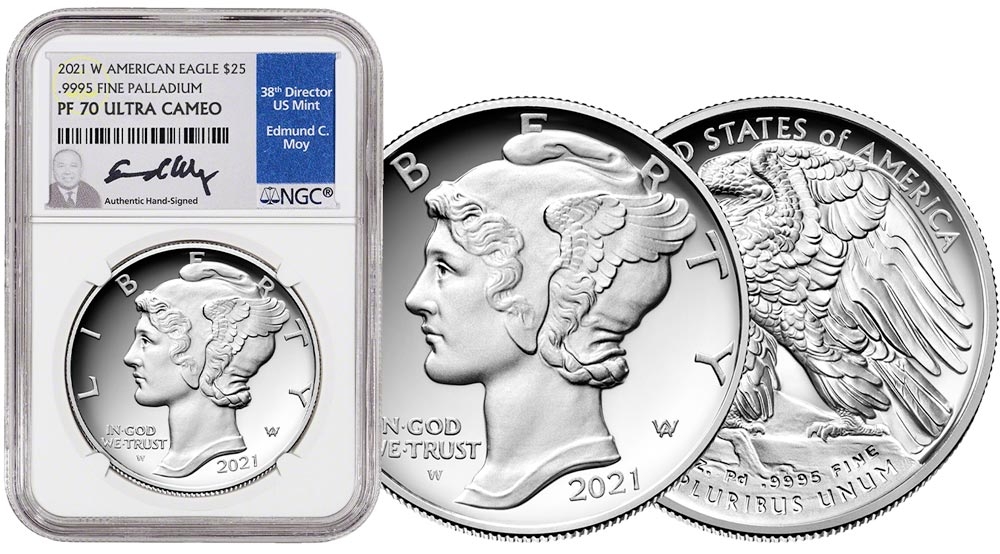

Palladium American Eagle Proof 70 Coins
More Rare Than Gold
In Partnership With Ed Moy, Former Director of the U.S. Mint, All Coin Labels are Hand-Signed.
History of the Palladium American Eagle
The United States Mint made history in 1986 with the launch of its premier American Eagle coin program. Initially offering only gold and silver options, the program has expanded over the course of its multi-decade tenure to now include platinum and palladium options of its investment grade American Eagle coin.
The Palladium American Eagle was authorized by the United States Congress on December 14, 2010, in a piece of legislation dubbed the “American Eagle Palladium Bullion Coin Act of 2010.” The act updates section 5112 of title 31 of the United States Code to include a “$25 coin of an appropriate size and thickness…that weighs 1 troy ounce and contains .9995 fine palladium.”
Although the new palladium edition of the American Eagle coin program was approved in 2010, the first investment grade iteration of the series would not be released until more than half a decade later, in 2018. The authorizing law called for a “marketing study” to be conducted and submitted to the United States Treasury Secretary before production and issuance of the new coin. The law further elaborated that the required “study” was defined as “an analysis of the market for palladium bullion investments,” and further specifies that it should be “conducted by a reputable, independent third party that demonstrates that there would be adequate demand for palladium bullion coins produced by the United States Mint to ensure that such coins could be minted and issued at no net cost to taxpayers.”
Finally, after several years of researching and studying, the first investment grade Proof Palladium American Eagle was struck and issued in 2018 (following its bullion counterpart’s release the year prior).
The investment grade Palladium Eagle is unique because each year, the coin is struck with a finish type that differs from the year before. The Palladium Bullion Coin Act requires that "to the greatest extent possible…the surface treatment of each year's proof or uncirculated version differs in some material way from that of the preceding year."
The alternating finishes by year include:
2017: Bullion version
2018: Proof Finish
2019: Reverse Proof Finish
2020: Uncirculated Finish
2021: Proof Finish
2022: Reverse Proof Finish
2023: Uncirculated Finish
The 2010 act also notes that proof versions of the Palladium Eagle must be struck at the West Point Mint in New York.
Additionally, supplies of the palladium bullion that are to be used in the production of the Eagle coins must be “mined from natural deposits in the United States, or in a territory or possession of the United States,” unless no such supply is available, or if it is not economically feasible to do so. This domestic supply stipulation makes the Palladium American Eagle a truly American coin!
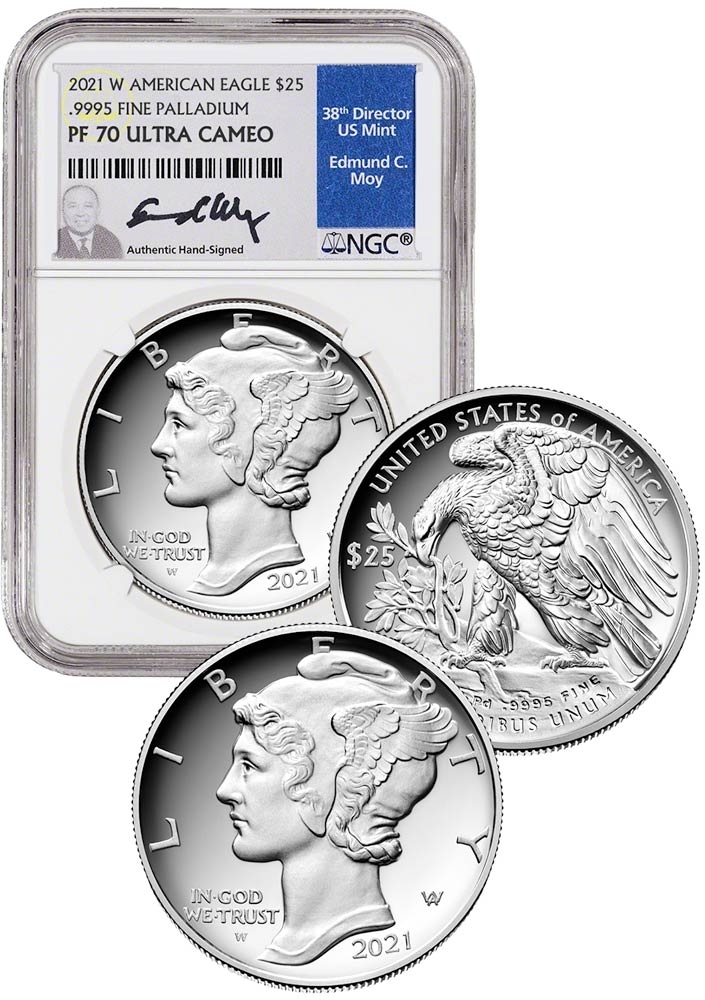

The Palladium American Eagle Full Date Run


Palladium American Eagle Design
The Palladium American Eagle features the same obverse and reverse designs each year. Each design is a high-relief replica of a classic U.S. coin image created by the famed American designer and medallic artist Adolph A. Weinman.
On its obverse, the Palladium Eagle bears the likeness of Weinman’s renowned “Winged Liberty” design, which was struck on the United States ten-cent circulating coin from 1916 to 1945. The design features a profile portrait of a young Lady Liberty donning a Phrygian – or “liberty” – cap with wings attached to either side. Because of the wings, this early 20th-century depiction of Liberty was often mistaken for the Roman god Mercury, who is also often shown wearing headgear with wings on its sides. This conflating of the two figures led to the colloquial nicknaming of the ten-cent coin as the “Mercury Dime.”
While Weinman never technically disclosed the identity of his model for the Winged Liberty design, the portrait is widely believed to be based on a sculpted bust the artist had created a few years earlier, in 1913. The model for that piece was Elsie Stevens, the wife of Wallace Stevens, an insurance executive, lawyer, and, of later fame, a poet who rented an apartment from Weinman around the time he created the 1913 bust.
The obverse of the Palladium Eagle also bears the inscriptions: “LIBERTY,” “IN GOD WE TRUST,” the “W” mint mark, indicating production at the West Point Mint, the coin’s strike year, and the artist’s mark, which is represented as an intertwined imprint of Weinman’s initials, “AW.”
On its reverse, the Palladium American Eagle features another early 20th century Weinman design. Here, the coin bears a high-relief iteration of the motif initially appearing on the backside of the American Institute of Architects Gold Medal in 1907. The image depicts an American eagle perched atop a boulder, or perhaps a mountain peak, pinning a branch down with its right talon while breaking a piece of the branch off with its beak.
The Mint utilized the original reverse plaster of the 1907 AIA medal in the development and production of the modern-day Palladium Eagle. The striking of the Palladium Eagle marks the first time a U.S. coin bears Weinman’s AIA design.
In addition to the eagle image, the reverse of the Palladium Eagle features the inscriptions, “UNITED STATES of AMERICA,” the coin’s “$25” face value, its “1 OZ. Pd .9995 FINE” palladium contents, and the motto on the Great Seal of the United States, “E PLURIBUS UNUM.”
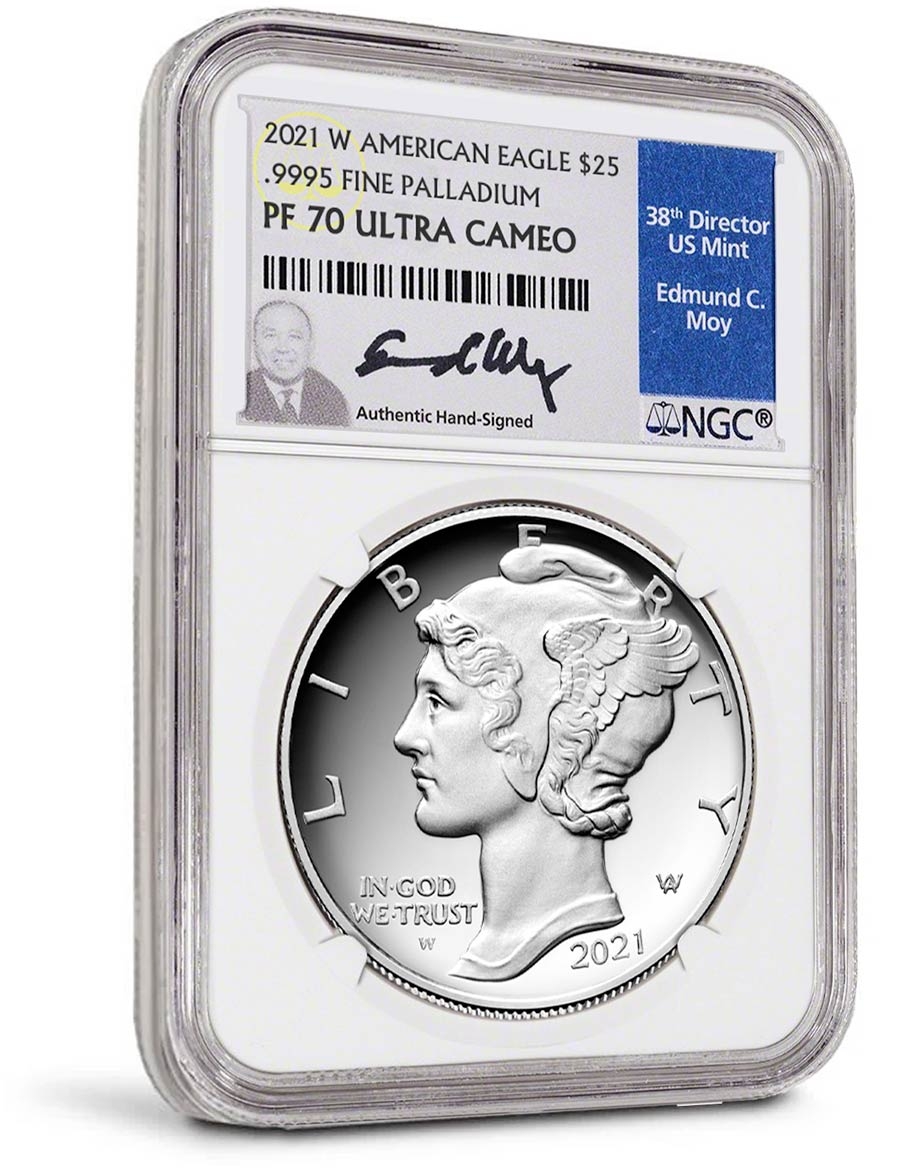

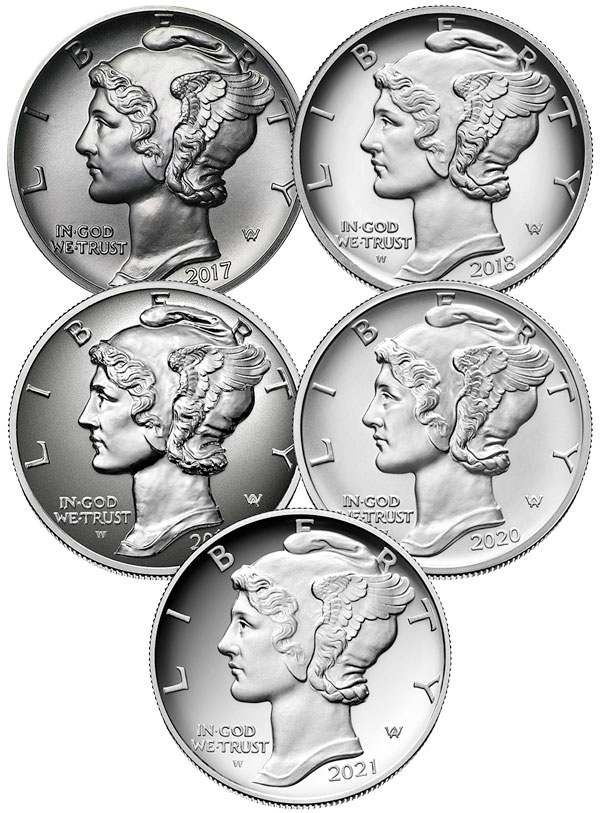

Each Year’s Issue Has a Different Finish
The 2010 Palladium Bullion Act stipulates that, “to the greatest extent possible,” the strike finish of each year’s proof or uncirculated issue must differ “in some material way” from that of the prior year's issue. This stipulation has led to the suite of investment grade Palladium Eagles being comprised of coins struck in an array of finishes, giving the program a unique appeal with the opportunity to invest in a varying style of coin each year.
In 2018, the investment grade Palladium Eagle was struck in the classic proof finish, followed by a reverse proof finish in 2019, an uncirculated finish in 2020, and another classic proof finish in 2021.
The classic proof is one of the most familiar investment grade pieces on the market today. According to the Mint, proof coins are the “finest quality of coin produced by the United States Mint.” They are identified by their high-sheen, mirror-like fields, the recessed or “background” portions of the coin, and frosted devices, the raised portions. The combination of the mirrored fields and frosted devices, known as the “cameo contrast,” is achieved by burnishing, or polishing, the starting metal planchet before beginning the striking process. This burnishing works to eliminate any imperfections on the surface of the planchet from the outset. Following burnishing, the planchet is bathed in a solution to remove any contaminants or debris from its surfaces. After the planchet is fully prepared, specially made proof dies are used to impress the coin’s design images onto either side of the metal base. Each proof coin undergoes at least two rounds of striking during its production process, ensuring the highest quality images and inscriptions appear and producing the cameo contrast that has become emblematic of these highly sought-after investment grade pieces.
Conversely, a reverse proof finish displays the cameo contrast of a proof coin in the reverse pattern, as the name would imply. With reverse proof coins, the fields are frosted, and the devices are mirror-like. Reverse proof coins are struck in the same manner as classic proofs, undergoing the same steps and receiving the same unique treatments described above.
Uncirculated coins differ somewhat from proof and reverse proof coins. As the Mint explains, Uncirculated coins are "made like circulating coins…but with a special process that produces a brilliant finish." Unlike their circulating counterparts, uncirculated coins are not intended for use as everyday money. An uncirculated coin is produced by loading a specially burnished blank into a coining press by hand and impressing the coin designs onto either side of the metal piece to create the final coin. The uncirculated strike process produces "a soft, matte-like finish appearance," as the Mint points out, and includes several quality-enhancing steps that help set these coins apart from those of the circulating variety. These enhancement measures range from "slightly higher coining force” to “early strikes from dies” to “special cleaning after stamping.”
All investment grade iterations of the Palladium American Eagle may be graded to solidify the coin’s quality and potentially bolster its long-term value. Coin grading is a process through which an independent industry authority like the Numismatic Guaranty Corporation (NGC) assesses a coin on a variety of quality metrics such as image clarity, the magnitude of surface blemishes and strike quality, and issues a score based on the coin’s performance in these assessment areas.
NGC employs the industry-standard and internationally accepted Sheldon scale to assess coins and issue grades. The Sheldon scale – a 70-point rubric – was developed and presented by American psychologist and numismatist William Herbert Sheldon in 1949 and has been used by NGC since its founding in 1987. Coins receiving a grade of 1 on the Sheldon scale, according to NGC, retain "enough detail to identify the coin's date and type," but its rims are "nearly flat." On the opposite end of the spectrum are perfect-score 70 coins, which NGC notes have "no post-production imperfections at 5x magnification."
Both proof and uncirculated coins can be graded on the Sheldon scale. Grades for each strike type comprise a lettered portion that can be represented as an abbreviation and a numbered portion that reflects the coin's quality score from the numeric rubric.
The lettered portion for proof coins is always “Proof” or “PF,” while the numbered portion will range from 1 to 70 depending on each coin’s quality. For example, a proof coin assessed to be of the highest quality, according to the Sheldon scale, would receive a grade of “Proof 70” or “PF70,” while a proof coin of the lowest quality would receive a grade of “Proof 1” or “PF1.”
Uncirculated coins differ slightly in the naming convention for their assigned grades. While these coins do follow the same 1-70 numeric rubric that proof coins do, the lettered portion of the grade varies depending on the score itself, a fact that is inconsistent with the naming convention of proof coins. Uncirculated coins that receive a numeric score ranging from 60 to 70 receive the lettered label “MS,” meaning “Mint State.” Uncirculated coins ranking below the 60-point level on the Sheldon scale receive varying lettered portions depending on the specific score.
An investment grade coin derives its value from its relative rarity within the market versus its weight like bullion and other commodities. Investment grade precious metal coins do not trade on an index, and their values are therefore not subject to the ups and downs of the commodities market. While the value of an investment grade coin does respond to market influences like consumer demand, its general quality, its relative rarity, and its artistic appeal, it behaves in a way more akin to that of a piece of fine art or a classic car, rather than a commodity like oil, wheat, or coffee beans.
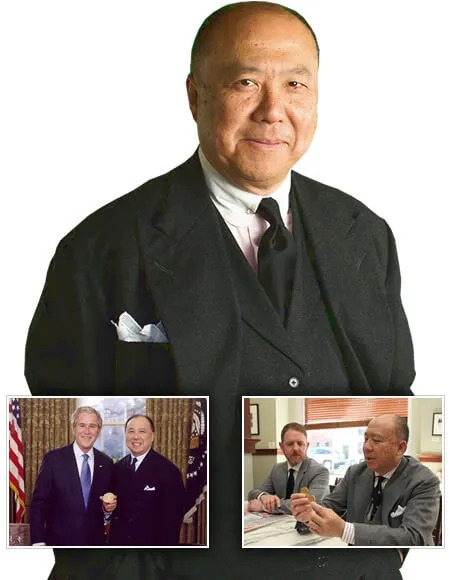



Ed Moy Signature Series Proof 70 Coins
Wholesale Coins Direct has partnered with former Director of the U.S. Mint, Ed Moy, to offer hand-signed certification labels on our Investment Grade Palladium American Eagle Proof 70 coins. The Ed Moy Signature Series of Palladium American Eagle Proof 70 coins will be highly sought after by investors and collectors and is exclusive to Wholesale Coins Direct, meaning population for Proof 70 coins and Date Runs will be extremely low, adding to their investment potential.
In addition to being the 38th Director of the United States Mint, Edmund C. Moy is a well-known author, economist and public speaker. He served as Special Assistant to President George W. Bush for over five years and assisted with the transition to the new U.S. Department of Homeland Security after September 11, 2001. The U.S. Mint sold over a $1 billion in numismatic collectibles and struck over 16 billion coins in Moy’s first year as Director. During his tenure as leader of the U.S. Mint, the financial crisis, and recession spurred an unprecedented demand for gold and silver bullion. The 50 State Quarter program, the Presidential $1 Coin, and the National Parks Quarter program were also milestones of Ed Moy’s term with the U.S. Mint.
Coins with Ed Moy signature labels have made headlines due to their extreme popularity and premiums investors are willing to pay at auction. The Ed Moy Signature Series of Palladium American Eagle Proof 70 coins are no exception and are an excellent way to diversify your portfolio within precious metals.
Ed Moy Signature Series Palladium American Eagle Proof 70 are available as single coins, 4-coin sets, and even a full Date Run featuring one of each Palladium American Eagles minted since 1997. Demand for these hand-signed coins is expected to outpace supply as investors and collectors realize the tremendous investment potential of these coins. Please contact us for more information about this incredible opportunity available exclusively through Wholesale Coins Direct.
